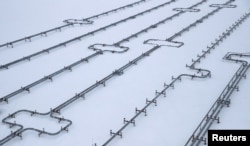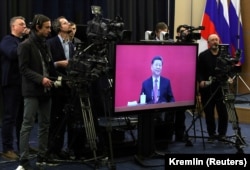When senior managers at Kremlin-controlled natural gas producer Gazprom arrived in New York in February 2020 to present a business update to U.S. investors, the company had just wrapped up the best three-year stretch in its export history.
Gazprom had delivered an average of nearly 200 billion cubic meters (bcm) of natural gas a year via pipeline to Europe, including Turkey -- one-third more than the average over the previous decade – and generated more than $120 billion in revenue over that period.
The management team told the U.S. investors that it expected Gazprom’s exports to Europe to remain around that record level for the next decade, extending the financial windfall for the company -- a key pillar of the Russian economy -- far into the future.
Two years later, the prognosis is starkly different. Russian President Vladimir Putin’s decision to launch a large-scale assault on Ukraine – and his moves to cut gas exports to the European Union over its support for Kyiv following the February 24 invasion -- have cost Gazprom that lucrative future on the continent, experts say.
The company -- considered a Kremlin “slush fund” because of its business ties to friends and close associates of Putin -- stands to lose hundreds of billions of dollars in European revenue over the long term. And that bleak outlook will have ripple effects on Gazprom’s efforts to compensate with a pivot to Asia by undermining its negotiating position with China, experts said.
In the short term, though, Gazprom can expect to enjoy a bonanza.
Even as its volumes to Europe tumble, the company will generate record export revenue this year -- and strong earnings over the next two to three years -- because prices for the fuel have surged amid a shortage triggered by what Brussels has called Kremlin “blackmail.”
But by mid-decade, as new supplies of natural gas flood the market and the EU further cuts Russian gas imports, Gazprom will face a sharp drop in revenue and profits at a time when the rest of the economy will be struggling under Western sanctions, analysts say.
Gazprom’s rising exports to Asia will not offset the lost income. The impact on Russia will be meaningful as Gazprom is one of the nation’s largest companies by revenue, employees, and capital expenditures, and is a major contributor to the federal budget.
'Off The Boil'
“Gazprom is not just losing a commercial opportunity -- and taxes for the state -- but also actively destroying its own market,” Nadia Kazakova, an analyst at the U.K.-based Renaissance Energy Advisors, told RFE/RL.
“Gas prices in Europe will eventually come off the boil but Gazprom will never recover its market share,” she said.
In Russia’s long-term planning for Gazprom, it was never supposed to be Europe or Asia -- it was supposed to be both, with eastward exports serving as a growth driver for the company and the country. Gazprom possesses the world's largest reserves of natural gas, enough to supply both continents with large quantities of the fuel for decades.
Before the February invasion of Ukraine, Gazprom had been Europe’s biggest gas supplier, accounting for about one-third of the continent’s needs.
Putin apparently did not expect that to change. He was clearly confident of a quick and decisive victory in Ukraine -- one that would subordinate Kyiv to the Kremlin -- and analysts say he apparently believed the West would grudgingly accept that outcome, with the United States and the EU imposing limited sanctions as they did after Moscow’s seizure of Crimea from Ukraine in 2014.
Instead, the European Union has vowed to sharply cut imports of Russian energy, including gas, to deprive Moscow of revenue for its military campaign -- albeit gradually, at a pace aimed to ease the pain for EU countries and their citizens.
Putin has tried to turn the tables on the EU by reducing gas flows to the bloc at a faster pace, helping drive prices to record highs and sparking fears that Russia might completely halt exports this winter.
Natural gas is largely used for heating homes and buildings in winter, in industrial processes, and for generating power.
“Right now, Russia [is] calling the shots,” said Karolina Siemieniuk, a gas analyst at the Norway-based research firm Rystad Energy, in a July 26 note.
'Russia’s Game Plan'
Kazakova said she does not expect Putin to completely cut off gas exports to Europe.
“Russia’s game plan is to keep exports to Europe flowing at a level which allows the government to collect sufficient revenues and taxes but potentially keeps Germany’s gas market short,” she said.
Germany had been the largest importer of Russian gas in Europe.
Based on current prices and volumes, Kazakova expects Gazprom to earn $79 billion in European export revenue this year and $67 billion next year, far surpassing the record $51 billion it received in 2021.
Sergei Vakulenko, a Bonn-based independent energy analyst, said in a post that some Russian officials may be betting that a peace deal on Ukraine will include an agreement with the West on long-term Russian gas supplies and forgiveness of legal claims stemming from cutoffs.
Such a wager on the Kremlin’s part would be a “colossal miscalculation,” Ed Chow, an energy analyst at the Washington-based Center for Strategic and International Studies (CSIS), told RFE/RL.
Even if the war in Ukraine were to end immediately, irreparable damage has been done to the decades-old symbiotic gas relationship between Europe and Russia, he said.
“After building a reputation as a reliable gas supplier for more than 50 years, Russia has thrown it out the window in five months,” Chow said.
Moscow never cut off its gas supply to Western Europe for political gain during the Cold War. Rather, it served as a bridge between the two camps, analysts said.
Bread And Butter
European sales have been Gazprom’s bread and butter over the decades, accounting for around 70 percent of the company’s gas revenue and 40 percent of total revenue.
Gazprom, which sells more gas by volume domestically than it sells to Europe, also generates revenue from oil and power production.
European sales enabled Gazprom to overcome the turbulent 1990s, when Russia was transitioning to a market economy and many households and companies could not -- or would not -- pay for gas.
Grasping the potential power of Gazprom’s influence at home and abroad, Putin quickly took steps to consolidate his control over the company after first taking office in 2000.
In May 2001, a year after his inauguration, Putin ousted the company’s long-serving chief, Rem Vyakhirev, and installed Aleksei Miller, a loyalist from his hometown of St. Petersburg. Miller runs the company to this day.
Putin early on defeated bids by powerful business interests to break up Gazprom and end its monopoly on pipeline exports. He also began using it as a foreign policy tool -- mainly, at first, in scraps with other former Soviet republics.
'Last Hurrah'
Looking to the future, Europe’s gradual shift toward alternative sources of energy to combat climate change meant that Russia’s revenue from fossil fuels sales to the continent would eventually decline.
But the Kremlin could have still expected “two more decades of abundant ‘last hurrah’ oil and gas revenue,” Thane Gustafson, a professor at Georgetown University who has written several books on Russia’s energy industry, said in a recent post.
“The invasion will likely shorten that period of respite,” he said.
The International Energy Agency (IEA) forecasts that Gazprom’s pipeline exports to Europe will fall to about 80 bcm by 2025 -- about 40 percent of the peak reached in 2018.
The EU, which accounts for the lion’s share of Europe’s gas demand, has said it will aim to end Russian gas imports by 2027 though some analysts say that could be hard to achieve.
James Henderson, chairman of the gas research program at the Oxford Institute for Energy Studies, said that Europe does not need to completely halt Russian gas to end Kremlin influence over the sector.
He said that reducing Russia’s share of the European gas market to less than 10 percent, or less than 50 bcm annually, would essentially end Moscow’s sway if those exports were spread around many nations.
'Second-Best'
As Gazprom loses its dominant position in Europe, it is seeking to widen its footprint in Asia, especially in the fast-growing gas market of China -- a shift that coincides with Moscow’s sharpening geopolitical turn toward Beijing amid increasing isolation from the West due to anger and dismay over its unprovoked war on Ukraine.
Russia could begin exporting additional volumes of natural gas to China through a new pipeline by as early as 2027 -- just when the EU aims to end imports -- if the two sides can reach a deal, said Henderson.
Moscow and Beijing have been in talks for years over Power of Siberia 2, which would carry up to 50 bcm of natural gas to China from fields on Yamal, the peninsula in northwestern Siberia that supplies Europe with fuel.
Russia is currently exporting gas to China through Power of Siberia 1 from fields in Eastern Siberia. That pipeline is expected to reach its maximum capacity of 38 bcm in 2024.
Russia’s loss of the European market makes a deal with China more urgent and thus weakens the Kremlin’s negotiating position, Chow said.
It is a case of deja vu.
The Kremlin was desperate to sign a deal with Beijing for Power of Siberia 1 after the West first slapped sanctions on Russia in 2014 following the occupation and takeover of Crimea.
China was able to clinch an agreement at a very attractive price, Chow said.
Kazakova, the U.K.-based analyst, estimated that China in July paid about a quarter of what Europeans paid for Gazprom’s pipeline gas.
Russia is simply late to the Asian energy market and will never achieve the dominant position it had in Europe, Nikos Tsafos, the chief energy adviser to Greek Prime Minister Kyriakos Mitsotakis and a former analyst at CSIS said in a May note.
“In volume terms, Asia could maybe match Europe one day as a market for Russian gas, but as a source of income and geopolitical heft, Asia will be a second-best alternative.”
















